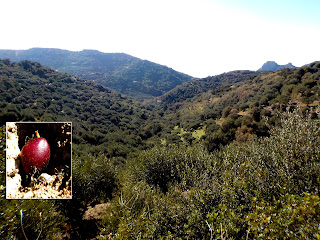I think that I may have lulled you into a false
sense of security last week with all that beauty in Where Three Valleys Meet. Not that this week’s stage of the journey is any
less beautiful but it will require a head for heights and nerves of steel in
places. You have been warned! Those three mountain streams that were gently
carving out valleys have now got together and their combined force has carved through
the limestone like a knife through butter and we’re going to try and get
through there. If you’re up for it, follow me.
Not surprisingly, as we enter this damp, almost
subterranean gloom, we have fungi. The creamy brown jobs running up the length
of this fallen tree are of the Crepidotus
genus which is based upon the Greek for cracked ear. Many different species
have been described in the past but modern phylogenetic analysis has shown that
the same species can show different growth forms depending upon where they are
growing. Essentially, like us humans, they can look very different but
underneath they’re all the same. The gorgeous little yellow fellow is a wax cap
of the Hygrocybe genus and these are
rather unusual in that recent research has shown that they seem to have a
symbiotic relationship with mosses and other bryophytes. As usual we are
constantly discovering new ways in which elements of nature are working
together.
I think we need to do a bit of climbing here. If
you’d like to flip a few rocks I’m just going to shin up this overhanging pine
and spy out our route. What have you got there? One grey and one orange
woodlouse. Why? I believe that it is down to a genetic variation. The orange
one, being more conspicuous, is more likely to be predated and so the grey form
predominates. Did you know that the woodlouse is one of the true blue bloods of
the animal world? Instead of having rich, red haemoglobin in their blood (see How To Get Blood Out Of A Stone) they have haemocycanin that uses copper to bind with oxygen instead of
iron and their oxygenated blood is blue... um, you could have just taken my word
for it.
We seem to have reached a little shelf where we can
sit and catch our breath for a minute. Which is just as well as the next part
looks a bit strenuous. The sea squills are just beginning to push their dark
green leaves up from their bulbs and we have quite a swathe of little
buttercups. We have over twenty species of buttercup on Crete and the
distinctive leaves of these tell us that these particular ones are Ranunculus bullatus (subspecies cytheraeus if you want to be really
precise). And where we have flowers we now have a beetle. These delightfully
furry Tropinota flower chafers will
be all over the place in a month or two’s time but this one seems to be taking
advantage of an early harvest.
Now for the hairy bit. I did warn you but before we
risk life and limb have you noticed the crag martins dancing through the gorge?
You normally find them at this altitude and above but this winter I’ve seen
them down by the beach. We always think of bird migration as a long distance
affair but some birds are mini migrators – just a few kilometres north to south
or from higher to lower altitudes. Rock
thrushes and even ravens tend to move down from the mountains in cold weather
round here whereas white wagtails move up from the beaches where they bum
around in the summer and head for the shelter of the olive groves. If you’re
ready we’ll crawl along this little ledge and then scramble our way to the top.
My, but it’s a long way down. I’m not sure that your humming the theme from
Indiana Jones in my ear is helping.
The Extra Bit
You have to admit that the view from the top was
worth the knee-trembling climb. The whole of the lower valley stretched out
before us. All we have to do now is find a way to get down there.
I'll be popping back and forth between Crete and Athens over the next few weeks so please bear with me if I'm a bit slow in answering your correspondence. SD
*********************************************************************************
LINKS:
Naturalists
(the facebook page that accompanies this blog)
See detailed pictures at
http://www.inaturalist.org/login (search - people-stevedaniels-observations)























